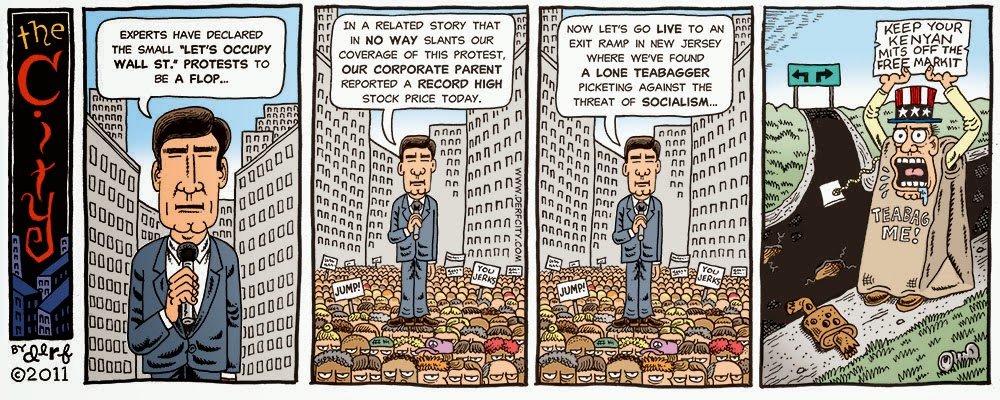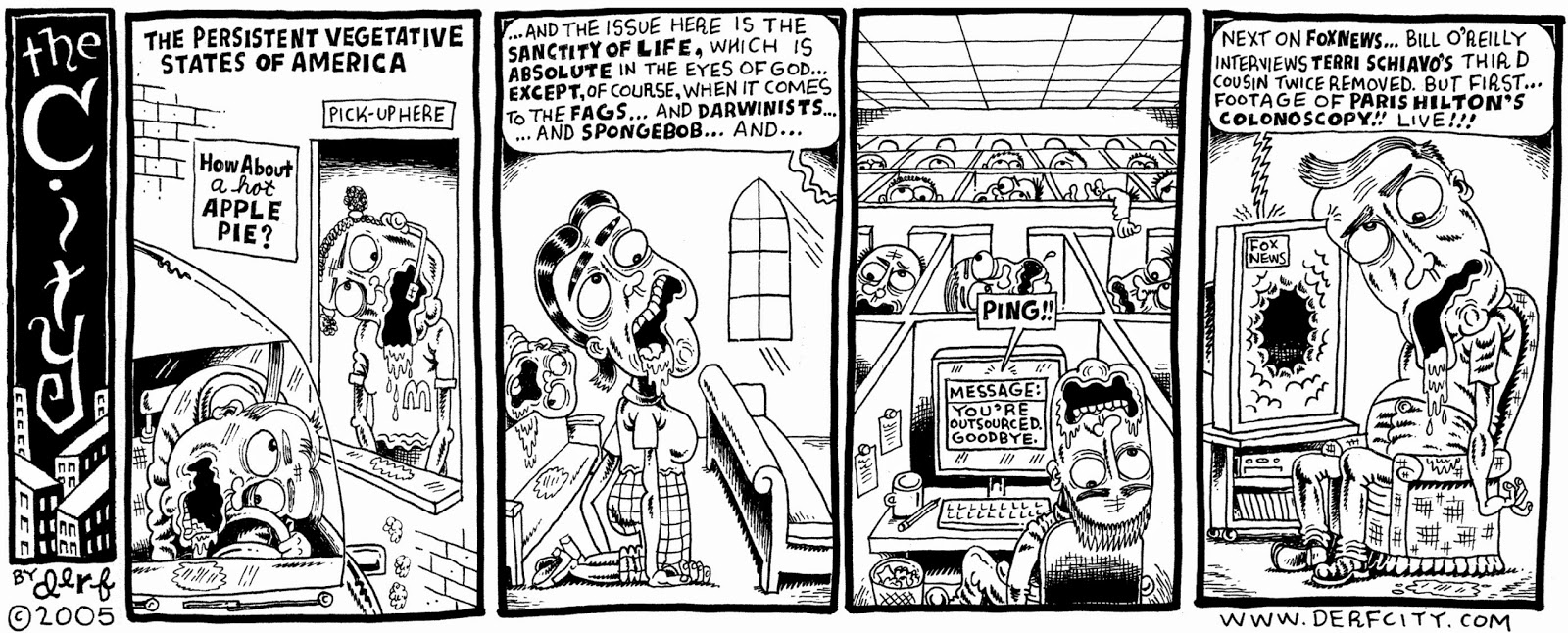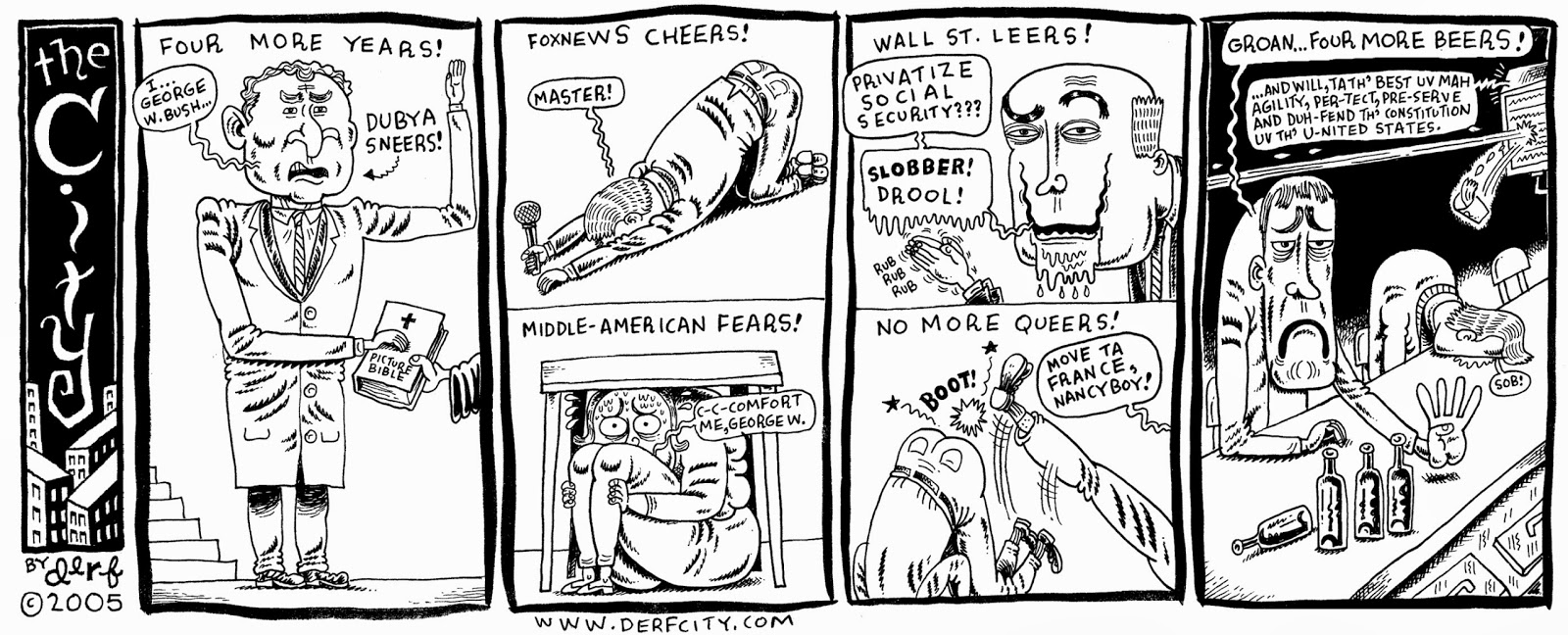The third decade of The City.
2010: As I slowly recovered from open-heart surgery, the masthead at Cleveland Scene, my base paper, was purged by corporate HQ. It all turned to shit fast. Management was sacked first, then the surviving staffers were axed one by one as the year unfolded. It was ghastly. The arts reporter got the heave just before Christmas! This business really sucked now.
The new regime, imported from other cities, disliked my work from day one. I'm told my cranky humor doesn't strike the proper tone. The new vision? A feelgood info-tainment paper filled with beer ads and LiveNation spreads. What can you do? Their paper, their call, but I didn't see a place for me in such a publication. I'd never been blown off like this before at a Cleveland weekly. Times had changed.
The strip wasn't great this year. A few keepers, but overall: meh. My mind was on other things.
LeBron blew off Cleveland in a nauseating, nationally-televised ESPN event. It's all anyone in town was talking about. I pitched this cover (above) to Cleveland Scene, a riff on the giant Nike ad on the building across the street from the arena. The editor turned it down. His reason? He was "sick of all the Lebron stuff." The cover story that week? As I recall, it was where to find great summer eats. Yeah, that had readers buzzing.
Previous editors at Scene, The Free Times or The Edition would have gone nuts for this cover. Hell, they probably would have made it into a t-shirt! This guy blew it off without a moment's hesitation. I would never pitch a cover to him again. Hard to deal with someone with that much of a tin ear.
Note that I went to a computer font for lettering (above). Another compromise for legibility's sake. It was easier to edit, which should have sped up the process, right? The opposite, actually. It took twice as long to make a strip as it did ten years ago. My brain was so wired for graphic novels and longform storytelling now, I lost the ability to write in four small panels! I start to dread the weekly strip deadline.
I also now went with a standard 4-panel layout, so I could send the strip out as a vertical. The remaining papers are shoe-horning the strip into whatever dwindling news hole is left, so I thought it wise to offer them options. This format looked better online, too.
2011: Wizard World magazine named The City one of its Next Top Webcomics. What the fuck!
Some of my cleverer colleagues, like Rueben Bolling and Tom Tomorrow, offset the loss of print clients by setting up subscriber sites. Fans pay a modest annual fee and in return get all sorts of extras. Worked great for these guys, but I decided to stick to my plan and kept transitioning to graphic novels.
In April, Abrams Books bought My Friend Dahmer! Above is a desk full of editing proofs.
The final Derf Page (above). It was hell to produce and the finished piece was pretty mediocre. The editor made me re-write it several times. Just because. Took about two weeks to make. Previously, Derf Pages took a couple days. I never volunteered to do another one after this ordeal, especially with what Scene was paying now. I was just biding time until My Friend Dahmer was released in six months.
In November, the Cleveland Poet & Writers League presented both myself and Harvey Pekar, recently deceased, with Lifetime Achievement Awards. It was a great evening.
2012: In January, Scene dumped my strip. By email! Above is the final strip. A friendly staffer, who had one foot out the door himself, warned me it was coming. This immediately became a huge clusterfuck as other local media wrote about my dismissal and an avalanche of angry emails came raining in. Scene execs were flabbergasted. I was grateful and humbled that fans cared that much. The publisher announced a week later, without ever bothering to contact me, that I was to be brought back later that month. I told Scene to "fuck off" on my blog. I never heard from anyone at the paper again.
In February My Friend Dahmer hit the books stores! Above is the moment when the first box of books (off the veritable slow boat from China) arrived on my doorstep. Twenty years of work resulted in this wonderful moment. Once again, my life changed dramatically, thanks to comix!
Then the other shoe dropped and the big media chain from Phoenix ended my exclusive contract as it purged ALL comix from its 15 papers. Just like that, I lost half my strip income and 75 percent of my print readership. St. Louis, Denver, Miami, Phoenix, Dallas, etc., the biggest weeklies in the biz. I could but laugh and shake my head. If not for the success of MFD, I would have been finished. Saved by graphic novels!
The entire weekly biz took a swan dive into the tar pit. The Creative Loafing chain, one of the biggest, with papers throughout the South, was seized by its largest creditor, which downsized everything to the bone (and, of course, axed all comix) and sold the papers off piecemeal. The NY Press, in the Nineties the finest comix paper of all the alts, closed. The Chicago Reader, as thick as a phone book every week just a decade earlier, was sold, downsized and then sold again, at a closeout price to the daily Sun-Times. The Village Voice, once the gold standard for alts, was now a sad, thin 60-page rag that rotted unread in newsboxes in NYC. The Other Paper in Columbus was bought by the daily Dispatch and immediately closed, just to eliminate a competitor (and frequent critic of the Dispatch's many fuck-ups and dirty deals). The San Francisco Bay Guardian, whose owner thundered against media conglomeration for years, cashed out and sold his paper to Hearst Inc. Even the big Phoenix chain broke up, a year after dumping me. Its owners got caught up in a sleazy scandal when its profitable online classified site Backpages.com was sued by a dozen attorneys general for underage sex trafficking. The libertarian owners offloaded their print division on a consortium of managers.
Here's a cover gallery from better days.
In 1990, I naively believed alt-weeklies would be the saviors of newspapers. At that time, Daily newspapers were nothing more than corporate product, after a decade of conglomeration, hopelessly antiquated and out-of-touch with their readers and their cities, and little more than shills for corporate interests and a few anointed One-percenters and their political allies. The watchdog press of the Sixties and Seventies was gone. Now it was free market good, unions bad. Dailies slavishly backed every $500M tax-abated civic project, especially sports stadiums, and rarely upset those in power. No one under 50 read them. They were out of touch, dumbed down and diminishing.
Weeklies in the Nineties were truly an "alternative"; locally owned, beholden to none of the local powers, cantakerous and creative. They wrote about things the dailies would not, in ways the dailies never would. They were the internet before the internet was born. The best weeklies attacked all of the dailies' sacred cows (although they had a few of their own) and often set the agenda in a city. They were relevant and boasted a college-educated readership ranging from 20 to 40 years old. They were put together by editors and writers, not by marketing surveys and focus groups. And they ran the best fucking comix in the world!
How depressing that, just 20 years later, the weekly press had not only aped the fatal mistakes of the daily press, they AMPLIFIED them! Mindless downsizing, chain ownership, copycat group-thing, packaging over content, shrinking comix to the point of irrelevancy, they did it all.
After the Phoenix deal was cancelled, there were but 15 weeklies still running the strip, mostly small and mid-size papers that were locally owned. Yet again, I seriously contemplated retiring it.
But then, just as I was about to shut it down, unexpectedly, the daily Plain Dealer wooed me and I agreed, perhaps foolishly, to do a Cleveland-only version of The City for its Monday edition. In B&W, just like the old days! It was a total dead end, of course, and only befuddled their septuagenarian readership, but they paid me more than any single paper ever had. Every time I decided it was time to shut it down, something happened to keep The City going! The Plain Dealer made a big deal out of my debut in the paper with a full page Q&A (above) to accompany my first strip. I never should have agreed to do it. I'm now grinding out two City strips a week, instead of developing future graphic novels. Idiot.
Hey, I give the PD editors credit for trying something new. In 1989, when I quit the PD to head out on my own, it would have been unthinkable that a strip like this could ever appear in that paper. That's why I left! Our subsequent relationship throughout the Nineties was openly antagonistic. They responded to my departure by blackballing me from freelancing for the paper and the editor bad-mouthed me around town. A bad move pissing me off, because I spent the next decade savaging the PD in cartoons and Derf Covers. Don't fuck with a cartoonist! Now, many PD regimes later, all had been forgotten and what was once inappropriate and cutting edge was no longer so. The intertube wiped out the line between the underground and the mainstream.
2013: Mon Ami Dahmer was released in France. It became the country's best-selling indy comic of the year. Back home, MFD was nominated for almost every comix award. I lost them all to Chris Ware's Building Stories. I mean, c'mon, that's not even a fair fight! The fucking thing comes with a board game, fer Chrissakes!
My first book tour of France and Belgium was one of the highlights of my career. A fan in Brussels (above) pulled out a copy of The City: Collected for me to sign. I was so touched! I drew him a White Middle Class Suburban Man on the title page. He was very happy.
When I returned home, after a year of constant touring and appearances, I started working on new book proposals.
In August, the Plain Dealer threw itself on its sword, bought out or laid off a third of its staff and downsized to 3-days-a-week publication. The Monday edition was axed, along with my strip. I knew it was coming. I had a nice two-year stint, but I knew that was the end of my run in Cleveland. There were no more publications left. I'd worked for them all!
2014: I signed a new contract with Abrams for my next book. I also unveiled The Baron of Prospect Ave. webcomic.
Mon Ami Dahmer won the Prix Révélation at the Angouléme International Comics Festival. There are the winners (above) up on stage at the award ceremony, posing for 50 photogs, like we're fucking Kardashians or something. It was totally unreal. Of all the great things that have happened to me in my career, this one is the tops so far. As I stood there blinded by flashbulbs and giddy from the adrenaline rush, I know there is no question that I should be doing more books, not more comic strips.
I toured throughout France and Belgium for the entire month of February. The French version of Punk Rock & Trailer Parks was released and it also becomes a bestseller!
The City is now in just 10 weeklies. Most of its readership comes from the GoComics site. It is no longer fun to crank out the strip every week. In fact, it's an ordeal. Frankly, I've run out of things to say. I'm also having great difficulty writing in the strip format. The open-ended freedom of graphic novels ruined me as a comic strip writer, just as the strip ruined me as a single-panel cartoonist all those years ago. I'm simply not smart enough to bounce back and forth between formats, I guess.
I held out until May, for the sake of serendipity. The City debuted in May, and that's when it ends. I do a third tour in France. I worked ahead, knowing that I'd pull the plug when I returned to the States.
The farewell strip (above). It's not a new strip. In fact, it's over four years old.
Here's the story. In 2009, I had that second go round with cancer. Well, not cancer specifically, but rather radiation damage from cancer treatment in 2003. They zapped me in the chest to kill a large tumor and the major arteries were so scarred up from the procedure that, six years later, I was in big trouble. I was rushed into surgery to re-plumb or replace everything. The surgeons were upbeat, as they always are, but I knew the score. So I drew this farewell strip and gave it to a buddy with instructions to post it if I didn’t make it
The idea came to me right away. No one under 40 probably gets the Carol Burnett connection, but who cares? Great goodbye tunes are surprisingly rare, and I didn't want to be weepy or anything. Go out with a smirk, that was the goal. But I survived, and the farewell strip got tossed on my pile of originals in my studio closet.
It wasn’t my plan to use it as my farewell strip this time, but when I sat down to write, I couldn’t think of anything but this one. It was stuck in my head. I was really running on fumes. It was also surprisingly emotional closing the strip down, and, to top it off, I was jet-lagged from my third trip to France. I knew I wasn’t going to come up with a better strip, so why fight it? Besides, it’s good karma to publish it on a happy occasion, not the tragic one it was originally made for. The only change is the third panel. I swapped out the original for one last shot at a Tea Party dickhead. Couldn't resist.
Even though I was at peace with the decision, it was tough hitting that "send" button. I planned to email it out to my papers on Sunday, so they'd have it first thing Monday morning, several days early, so they could have ample time to find a replacement strip. I just couldn't do it. Finally, Monday evening, I gritted my teeth and did the deed. I felt good afterwards.
I'm so happy I get to end it this way, not as a washed-up has-been slinking off in defeat, but on my terms.
It was a great ride.
And that's the end.




























































